Exploring the Dubai Metro Rail System: Key Insights
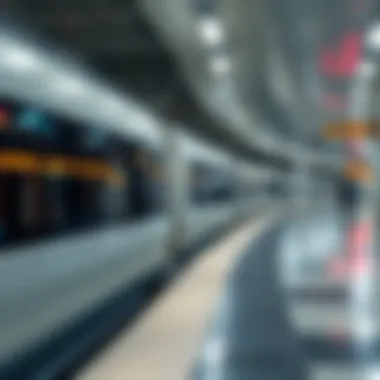
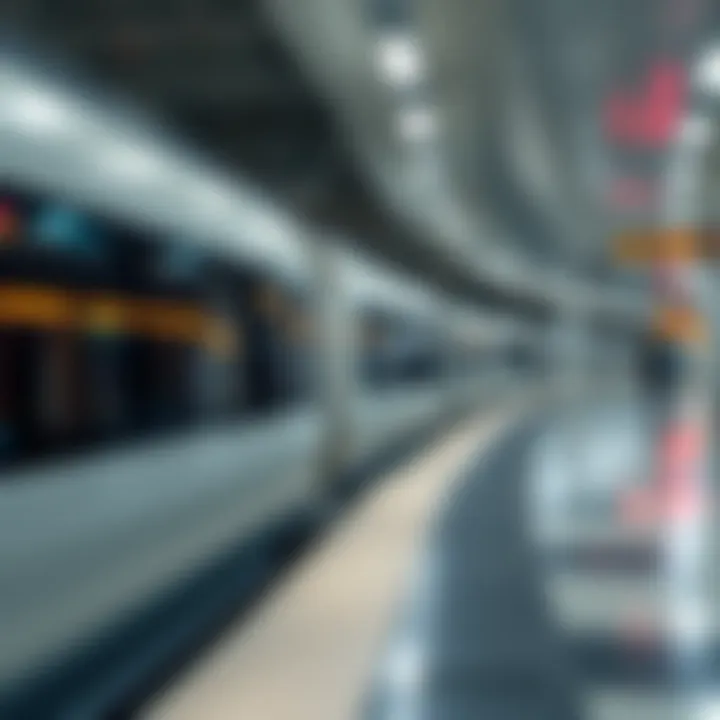
Intro
Dubai’s metro system isn’t just a mode of transport; it is a lifeline that connects the dynamic heartbeat of a city bustling with innovation. Understanding this transit marvel provides insight into not just getting from Point A to Point B, but also into the broader implications it has on urban living, economic growth, and real estate dynamics.
The metro trains in Dubai are effectively shuttles of cultural exchange, interlinking diverse neighborhoods while reshaping the fabric of the city. The operational trains, their significance within the urban network, and their anticipated growth are all pivotal components of a discussion that draws the interest of investors, homebuyers, and researchers alike. As this article unfolds, we'll delve into market analysis, lifestyle features, and future projections to give a rounded perspective on the implications of the metro system on Dubai.
Amidst the architectural wonders and modern amenities, the metro serves as a backbone to various lifestyles, commercial opportunities, and social interactions, thus playing a critical role in shaping Dubai's real estate landscape. 💡 Without further ado, let’s explore the market trends, economic factors, and lifestyle offerings that revolve around this moving infrastructure.
The Metro System in Dubai
Dubai’s metro rail system is more than just a mode of transport; it stands as a testament to the rapid development and forward-thinking nature of the city. Designed to alleviate the pressures of urban congestion, the metro plays a crucial role in structuring the everyday lives of residents and visitors alike.
From enhanced connectivity to sustainable travel options, its significance is multi-faceted. The increased accessibility granted by the metro encourages economic activity, particularly in areas surrounding the stations, paving the way for flourishing businesses and thriving communities.
Moreover, with the cosmopolitan vibe of Dubai, the metro is a blend of efficiency and culture, offering a glimpse into the city’s artistic endeavors through the design of its stations. The high standards in operation reflect Dubai’s aim to establish itself as a global hub, appealing to tourists and investors. Such developments enhance the overall quality of life, making the metro indispensable in today’s landscape.
Prelims to Dubai's Metro
The introduction of the metro system in Dubai was a bold step into modern public transport, aimed at addressing the challenges of an expanding urban population and increasing traffic. Launched in 2009, it was one of the most ambitious infrastructure projects in the region, designed to not only facilitate movement but also support environmental goals through reduced emissions.
As of now, the metro encompasses a network of over 75 kilometers, connecting key areas throughout the city. This includes two primary lines: the Red Line, which runs from Rashidiya to UAE Exchange, and the Green Line, stretching from Creek to Al Jaddaf.
The design of the metro stands out, characterized not just by sleek trains, but also by an aesthetic that reflects Emirati heritage through art and architecture. Furthermore, the subway and above-ground sections provide an unparalleled overview of the cityscape, making the journey an experience in itself.
Overview of Current Operations
The operational aspect of Dubai’s metro is nothing short of impressive. With trains running every few minutes during peak times, it is designed for efficiency and convenience. The automated system ensures that passengers experience smooth, reliable travel, coupled with real-time updates delivered through digital screens throughout stations.
The metro operates daily, with extended hours on weekends, catering to diverse needs, whether it’s commuters heading to work or tourists exploring the city. Currently, there are more than 100 trains serving the network, each equipped with modern amenities designed for comfort and safety.
Furthermore, Dubai’s Roads and Transport Authority (RTA) continually evaluates systems to ensure safety protocols are followed diligently, establishing a secure environment for all passengers. The following points summarize current operational highlights:
- Frequency: Trains arrive every 2-3 minutes during busy periods.
- Coverage: Extensive reach, connecting suburban areas to the city center.
- Safety Features: Compliance with international safety standards to mitigate risks.
The Dubai metro is not just a transport system; it’s a pulse, channeling the energy of a city in perpetual motion.
In summary, the metro system in Dubai is a well-oiled machine that continues to evolve, offering substantial growth opportunities while enhancing the quality of urban life. As the city progresses, so does its dedication to improving transportation, making the metro a cornerstone of modern Dubai.
Number of Metro Trains in Dubai
The number of metro trains in Dubai serves as a crucial indicator of not only the efficiency of the public transport system but also reflects the city's commitment to sustainability and modern urban solutions. Understanding this aspect can provide insights into how Dubai manages its rapid urbanization while simultaneously addressing the needs of its residents and visitors. With a growing population and increasing economic activities, sufficient metro trains are vital for maintaining connectivity across the city.
Total Count of Operational Trains
As of now, Dubai operates approximately 149 metro trains across its red and green lines. These trains play a significant role in accommodating the throngs of commuters who rely on the metro for everyday travel.
This figure represents a fine balance struck by the Roads and Transport Authority, which has invested heavily in this aspect of urban mobility. Unlike some cities, where overcrowding can often lead to discomfort, Doha’s efficient management structure allows for a well-planned rotation and schedule of trains.
- Red Line: Connecting many key areas, including the Dubai International Airport and major commercial districts, it is the longest route, spanning over 52 kilometers.
- Green Line: Complementing the Red Line, it primarily serves the educational and residential sectors, ensuring that no major area is left disconnected.
With high-frequency trains running frequently, especially during peak hours, this metro network alleviates road traffic congestion considerably. It’s estimated that about 230,000 people use the metro every day. The continuous increase in ridership reflects the trust and reliability travelers have with this mode of transport, fundamentally transforming how people navigate the metropolis.
Train Types and Models
Diversity in train types enhances the functionality of the metro system. Dubai's metro trains come in various models, mainly manufactured by well-known companies like Bombardier and Mitsubishi. This combination allows a seamless integration of advanced technology ensuring safety, efficiency, and comfort.
- Bombardier Flexity Outlook: This model is well-known for its spacious interior and cutting-edge safety features, appealing to many commuters.
- Mitsubishi Heavy Industries Trains: These trains are recognized for their reliability and are tailored to suit the operational environment of Dubai.
The trains are designed with user-friendliness in mind; there is room for wheelchairs and spaces dedicated to standing areas, which is essential for peak hour commuting. The air conditioning system, a necessity in the scorching heat of Dubai, operates effectively to provide a comfortable journey, ensuring that passengers are not left high and dry.
The ongoing assessment of train performance and passenger convenience continues to shape future upgrades to the fleet, demonstrating Dubai's commitment to maintaining a modern and effective mass transit system.
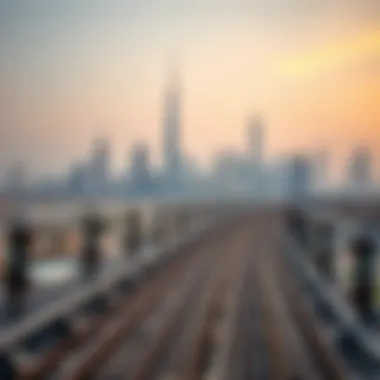
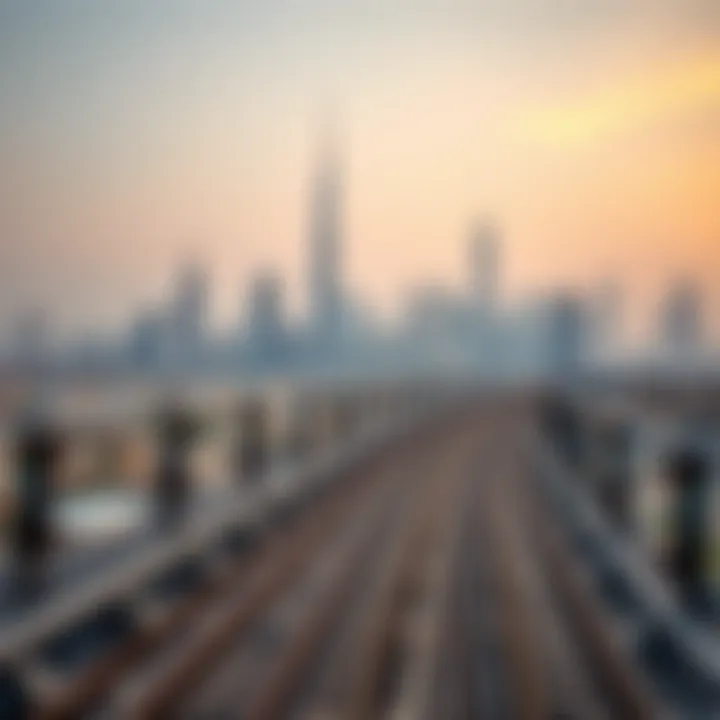
Significance of the Metro in Urban Mobility
The metro rail system in Dubai plays an indispensable role in transforming urban mobility within the bustling city. More than just a means of transport, it acts as a catalyst for economic growth, urban development, and social connectivity. Moreover, it provides a reliable and efficient alternative to private vehicles, significantly altering the dynamics of daily commutes. The importance of understanding the metro's significance is profound, especially for investors, homebuyers, and developers who seek to grasp how such systems influence urban landscapes and lifestyles.
Connectivity Across the City
Dubai's metro system offers exceptional connectivity, linking key districts with a network designed for efficiency. This rapid transit network effectively bridges the gap between residential, commercial, and recreational areas, making it easier for residents and tourists alike to navigate the city. Key stops include major hubs like the Dubai Mall, Dubai International Airport, and various business districts. Such strategic placements enhance accessibility, thus fueling economic activity and business growth.
- Stations as Hubs: Each metro station often doubles as a hub for other transportation methods, from buses to taxis, amplifying the connection with additional transport modes.
- Shortening Travel Times: Fast travel times mean less time in transit and more time for leisure, work, or family. The metro offers an average speed of 43 km/h, making it a quicker option compared to road travel during peak hours.
The integration of the metro with comprehensive urban planning demonstrates its vital role in shaping Dubai as a global city. A multi-modal transportation framework encourages the development of transit-oriented zones, fostering a balanced, sustainable urban environment.
Impact on Traffic Reduction
One of the pressing issues in any urban center is traffic congestion. In Dubai, the metro has emerged as a robust solution to traffic woes, significantly lessening road vehicle reliance. The growing ridership reflects this shift, with millions of journeys taken annually. By reducing the number of cars on the road, the metro not only alleviates congestion but also contributes positively to air quality.
- Decreasing Carbon Footprint: Public transport like the metro is much more energy-efficient. Each train can carry hundreds of passengers, meaning fewer individual car trips.
- Fostering Sustainable Practices: There's an ongoing commitment to promote the usage of public transportation. The authorities conduct various campaigns to encourage residents to opt for the metro over private vehicles, directly impacting the traffic flow.
"Investing in public transport yields dual benefits: enhances mobility and spurs urban growth."
By acknowledging the metro's role in traffic reduction, stakeholders in the real estate sector can better evaluate property values adjacent to this connective infrastructure. Smart investors should recognize how property demand correlates with proximity to metro stations, highlighting the essential nature of such transit systems in sustainable urban development.
Role of the Metro in Real Estate
The metro system in Dubai is not just a means of transport; it holds significant sway over the city’s real estate landscape. It's fascinating to observe how the mere presence of a metro station can alter the property dynamics in its vicinity. The metro acts as a backbone for urban mobility, enabling people to access a variety of amenities and services without having to rely on cars. This makes areas near metro lines especially attractive to homebuyers and investors alike.
Influence on Property Values
When discussing property values, the metro’s impact cannot be overstated. Locations that boast nearby metro stations often see a rise in property values due to increased desirability. A study conducted by the Dubai Land Department in recent years highlighted that properties located within 500 meters of a metro station appreciate more rapidly compared to those farther away. This surge can often reach up to 15% within a short time frame.
Several key reasons explain this phenomenon:
- Accessibility: Properties near the metro are easier to reach, which is particularly appealing for those who commute to work or enjoy hassle-free transportation to shopping and leisure spots.
- Convenience: People are keen on minimizing travel time. Being a stone’s throw away from a metro station means more time for what matters, be it family or leisure activities.
- Investment Potential: Savvy investors recognize the correlation between metro proximity and property demand. A development project near a metro line might command a premium price, not just for the property itself but for future resale as well.
Furthermore, the metro's ability to alleviate traffic congestion results in a more appealing urban environment. Buyers tend to steer clear of areas with heavy traffic and long commutes. Thus, properties situated in metro-adjacent neighborhoods become prime candidates for higher market value.
"A home near the metro is not merely an address; it’s a lifestyle choice that speaks to convenience and modern living."
Development of Transit-Oriented Communities
The implementation of the metro system has also ushered in the era of transit-oriented communities in Dubai. These are developments designed to maximize access to public transport while fostering walkable neighborhoods. The concept revolves around integrating residential areas, commercial spaces, and recreational facilities in proximity to metro stations.
Several characteristics define successful transit-oriented communities:
- Mixed-Use Development: These communities blend residential and commercial properties to create vibrant neighborhoods, reducing the need for residents to travel far to meet their daily needs.
- Pedestrian-Friendly Spaces: Streets are designed to encourage walking, cycling, and socializing. Well-planned sidewalks and bike lanes enhance the overall livability of these neighborhoods.
- Affordable Housing Options: The focus on creating diverse housing choices ensures that various income brackets can benefit from living near metro stations, which contributes to community inclusiveness.
Such developments have not only increased property values in their immediate areas, but have also sparked broader revitalization efforts across Dubai. The synergy between the metro system and real estate growth is evident, as neighborhoods evolve to offer both convenience and a quality way of life.
In sum, the metro rail system is a linchpin in the real estate puzzle of Dubai, weaving together increased property values and the growth of vibrant communities. Investors who recognize this connection stand to gain significantly as the city continues to expand and evolve.
Future Expansion Plans
The metro system in Dubai is not just a fixture of the present; it's a forward-looking project that aims to redefine urban transport in the coming years. Future expansion plans are vital for enhancing connectivity within the city and contributing positively to Dubai’s growth trajectory. Urban areas need efficient transport solutions as they evolve, and the expansion of the metro system is designed to meet these demands.
Upcoming Metro Lines
Forward-looking expansion routes are in the pipeline. Several new lines are set to come online, aiming to link various areas of the city that are currently underserved and improve overall accessibility. These future lines are planned with the intent to stretch further out from the existing routes, bridging gaps and reducing dependence on personal vehicles. The following key lines are anticipated to reshape the landscape:
- Red Line Extension: Fueled by the growing population in nearby districts, this extension will connect several new residential and commercial zones.
- Route 2020: Set to facilitate access to the Expo 2020 site, this line will further enhance Dubai’s public transportation offerings.
- Expo City Line: Aimed at catering to the influx of visitors, this line will simplify travel between existing venues and the new expo location.
In addition to these lines, enhancements are also being made to improve station facilities and increase capacity to accommodate the surge in passengers.
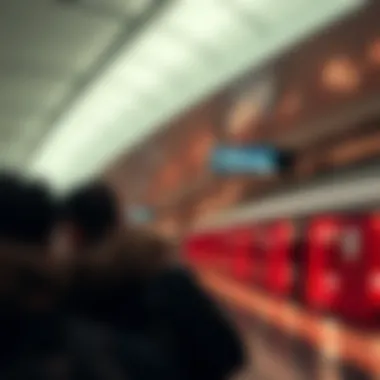
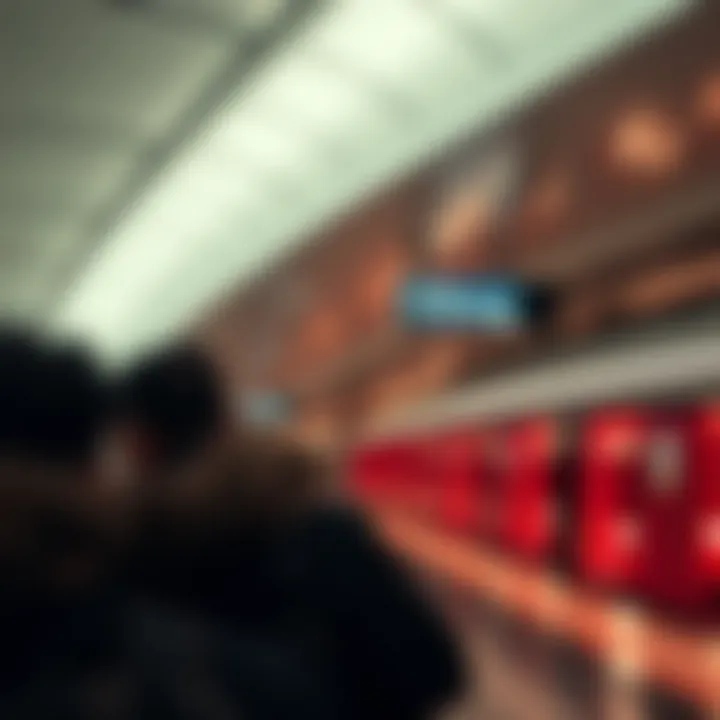
Technological Enhancements
Technology is playing a crucial role in the future of Dubai’s metro system. With smart innovations around the corner, these advancements will not only streamline operations but also enhance the overall riding experience. Here are some significant technological initiatives:
- Automated Train Operations: The move towards more automated trains promises safer operations and optimized schedules. With this technology, delays can be handled more efficiently, thus keeping commuters moving smoothly.
- Smart Ticketing Solutions: The introduction of contactless payments and digital ticketing systems will significantly improve convenience for passengers. Electronic fare systems will simplify the purchasing process and reduce queues.
- Real-Time Data Monitoring: Enhanced systems for real-time tracking of trains and passenger flow will provide commuters with up-to-date information, improving their experience and managing crowding effectively.
As the city grows, these technological enhancements are essential to maintain a modern transport framework. They will add layers of sophistication that benefit both locals and visitors.
In summary, the future expansion plans for Dubai’s metro system signify more than just added lines. They represent a commitment to sustainable urban growth, investment in technology, and a clear vision of connectivity tailored for diverse needs.
Intelligent Transport Systems
Intelligent Transport Systems (ITS) play a pivotal role in modern urban transit frameworks, especially in bustling metropolises like Dubai. These systems are designed to enhance the efficiency, safety, and convenience of transportation, integrating technology into the transport infrastructure. The deployment of ITS within the Dubai Metro amplifies the advantages of swift urban mobility while addressing the complexities of managing vast numbers of passengers and vehicles daily.
Smart Ticketing Solutions
The advent of smart ticketing solutions in the Dubai Metro reflects a significant leap toward more user-friendly and efficient fare collection systems. Traditional paper tickets are being gradually phased out, making way for contactless options that streamline the boarding process. For instance, the Nol Card has become a household name among residents and visitors alike, allowing seamless access not only to metro services but also to buses and water transport.
- Benefits of Smart Ticketing:
- Convenience: Users can recharge their cards easily through vending machines or online platforms.
- Cost Efficiency: Special pricing schemes can be applied directly, providing discounts based on usage patterns.
- Time Saver: Reduced waiting time at stations means quicker commutes, which is vital in a city known for its traffic.
Moreover, such systems promote better data collection practices, allowing the Dubai authorities to analyze travel patterns, adjust service frequency, and develop informed strategies to cater to growing demand. This responsive element fosters a more reliable transportation network, enhancing the overall commuter experience.
Real-Time Information Services
Another cornerstone of the Intelligent Transport Systems in Dubai is the implementation of real-time information services. As urban transport unfolds continuously, access to live updates becomes paramount for commuters. The Dubai Metro excels in providing accurate information on train schedules, delays, and even crowding levels in real time.
Key elements of real-time information services include:
- Display Boards at Stations: These digital screens provide passengers with live updates, eliminating uncertainty regarding train arrivals.
- Mobile Applications: Applications provide users with notifications and alerts on their smartphones, thus enriching their travel experience through timely information.
- Integration with Other Transport: Real-time data is shared across all modes of transport, ensuring that passengers can plan their journeys with an understanding of traffic conditions and service changes.
"The integration of intelligent transport systems illustrates a commitment to fostering urban mobility and improving citizens’ quality of life."
By leveraging intelligent transport solutions, the Dubai Metro not only enhances operational effectiveness but also instills a sense of trust and reliability among commuters. This comprehensive approach addresses various facets of urban transit, solidifying the metro's reputation as an efficient, modern transport system that caters to the evolving needs of a dynamic city.
Cultural Impact of the Metro
The metro rail system in Dubai extends its influence far beyond mere transportation. It stands as a testament to how infrastructure can foster cultural integration and promote community engagement. With its reach expanding throughout sprawl suburbs to the bustling urban core, the metro bridges gaps, connecting diverse neighborhoods and cultures. This section delves into the dual role of the metro as both a vital transit system and a cultural connector, facilitating exchanges that enrich the fabric of Dubai's dynamic society.
The Metro as a Cultural Connector
Dubai's metro service surely isn’t your average train commute; it intermeshes lives and stories. Every ride carries passengers from different walks of life—business professionals heading to meetings, tourists exploring the city, and locals going about their daily routines. As people from various cultural backgrounds share the confined space of a metro carriage, they inadvertently create an atmosphere of inclusivity and shared experiences.
- Cultural Integration: The metro serves as a melting pot of cultures, enabling connections that may not have otherwise occurred. Visitors from abroad often interact with Emiratis, learning about each other's traditions and ways of life while riding side by side.
- Accessibility to Cultural Hotspots: With stops strategically located near museums, galleries, and cultural centers, the metro functions as a conduit to the city's rich cultural landscape. It makes events like the Dubai Art Season and the Sheikh Mohammed Centre for Cultural Understanding accessible for a broad audience.
"The Metro has become a lifeline for people, offering not just transport but a glimpse into the lives of others. It’s remarkable to see how quickly different cultures can come together in such a space."
Through these interactions, the metro may also challenge preconceived notions, bridging divides and enhancing harmony within a diverse populace.
Art and Design in Metro Stations
The artistic endeavors behind Dubai's metro stations turn each stop into a gallery, merging functionality with creativity. Renowned artists and designers have been commissioned to transform utilitarian spaces into visual feasts, enriching the daily commute.
- Architectural Beauty: Stations like the Burjuman and Union have intricate designs that reflect the cultural heritage of the UAE. These elements not only catch the eye but also educate commuters on local traditions.
- Public Art Installations: Many of the stations feature artwork that tells stories, celebrating local culture and history. For instance, the artworks installed around the Khalid Bin Al Waleed station depict maritime heritage, connecting the land to its rich seafaring past.
- Interactive Experiences: Some stations incorporate technology, allowing travelers to engage with the art in innovative ways. Interactive displays might provide background information about the art pieces or offer historical context, enhancing the commuter experience.
The blend of art, architecture, and transport fosters a unique cultural environment that resonates throughout the city. By celebrating creativity, the metro amplifies the importance of art in public spaces, contributing to a vibrant community identity and a sense of pride among residents.
In summary, the cultural impact of the metro in Dubai reflects its role as more than just a transit option. It connects the city's diverse populations while showcasing the richness of local culture through art and design, making daily trips not only a journey of distance but a journey of cultural discovery.
Sustainability Initiatives
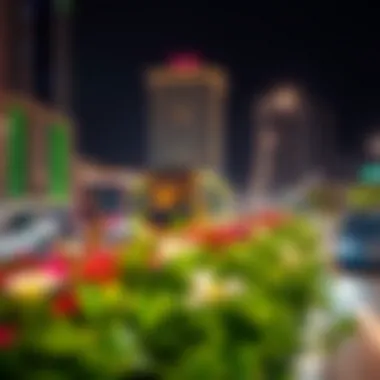

In the age of eco-consciousness, the importance of sustainability initiatives cannot be overstated, especially when talking about public transport systems like the metro rail in Dubai. The city's rapid growth has necessitated a strong commitment to sustainable development, ensuring not just ease of mobility for residents and tourists but also a significant reduction in environmental impact. The metro system stands as a testament to Dubai’s dedication to fostering sustainable urban living. This section dives into the energy efficiency measures and environmental awareness programs that play a crucial role in this ambitious approach.
Energy Efficiency Measures
Energy efficiency is at the heart of Dubai's metro system. Several measures have been implemented to ensure that the operation of trains minimizes energy consumption while maximizing performance. Here are some key energy initiatives:
- Regenerative Braking Systems: When trains slow down, energy is captured and sent back to the power grid. This smart technology reduces overall energy needs by reusing energy that would otherwise be lost.
- LED Lighting: Metro stations and trains are fitted with energy-saving LED lights. Compared to traditional lighting solutions, LED technology significantly lowers energy expenditure, contributing to a greener operation.
- High-Efficiency Trains: The latest models of metro trains have been designed with advanced aerodynamics, cutting down on energy per journey. Their manufacturing processes also prioritize eco-friendly practices.
The implementation of these measures contributes not only to reduced operational costs but also enhances the public's perception of the system as a leader in sustainable transport. People are more likely to support a system they perceive as environmentally responsible.
Environmental Awareness Programs
Beyond mere operational efficiency, the metro system in Dubai actively engages with the community in various environmental awareness campaigns. These programs aim to promote understanding of sustainability and encourage participation in eco-friendly practices:
- Public Education Initiatives: Dubai Metro frequently runs educational campaigns aimed at informing citizens about the advantages of using public transport. These initiatives not only highlight the substantiated lower carbon footprint of the metro compared to individual cars but also engage students through workshops and interactive sessions.
- Community Engagement Activities: Events such as community clean-up drives and tree planting initiatives are organized to foster a sense of shared responsibility. Involving locals makes them feel more connected to the transit system, reinforcing its importance within the broader context of sustainable urban living.
- Partnerships with Environmental Organizations: The metro collaborates with NGOs and other organizations to boost awareness. Such partnerships amplify the reach and effectiveness of the programs since they leverage existing networks.
"Investing in sustainability isn’t just about green tech; it’s about green hearts—fostering a culture of responsibility among citizens and employees alike."
Through these combined efforts, Dubai's metro establishes itself as more than just a transport solution; it becomes a community asset that champions sustainability and eco-awareness. Hence, initiatives fostering both energy efficiency and public engagement are vital, carving out a path for future growth that is grounded in care for the environment and community welfare.
User Experience on the Metro
Understanding how commuters interact with the metro system offers important insights into its effectiveness and overall contribution to urban transport in Dubai. The user experience on the Metro is not just about whether trains arrive on time; it’s about how easy and convenient it is for passengers to navigate the system from point A to point B. Elements such as cleanliness, accessibility, and passenger information all come into play here, significantly impacting the daily lives of thousands.
Commuter Insights and Feedback
Commuters often hold the keys to understanding the daily functioning of the metro system. Their feedback can reveal the strengths and weaknesses of the service. Surveys and interviews conducted with various passengers give a deeper insight into their interactions with Metro services.
Some common themes often emerge:
- Timeliness: Most commuters stress the importance of a reliable schedule. Delays can derail travel plans, making predictability a top priority.
- Comfort: Feedback regarding seating arrangements and station facilities might vary. It’s the little things—like clean restrooms and well-ventilated cars—that can uplift the commuter experience.
- Information Availability: Many find navigating the system easier with clear signs and accessible real-time updates. People have different needs; some may require language support or assistance with navigating maps.
- Affordability: The cost of fares impacts commuter choices. Generally, affordable pricing is appreciated by regular users and considered an important consideration when evaluating transit systems.
Continuous engagement with commuters is essential. By collecting and analyzing this type of feedback, the Metro authorities can stay ahead of dissatisfaction and make adjustments for enhancements.
Safety and Security Measures
Safety is paramount on any public transportation system, and Dubai's Metro is no exception. Measures implemented by the authorities prioritize the physical security of passengers, ensuring a safe commuting environment.
Some of the major safety and security measures include:
- CCTV Surveillance: Stations and trains are monitored by a network of cameras. This not only deter potential criminal behavior but also provides a means to investigate incidents if they occur.
- Emergency Response Procedures: Emergency protocols are established and regularly practiced, ensuring staff can react quickly and efficiently to any situation. Staff training includes how to address health issues and evacuate trains if necessary.
- Safety Personnel: Well-trained personnel are stationed at various points throughout the network to assist passengers and provide a sense of security. Their visibility can make a big difference to passengers, especially during busy travel times.
- Maintenance and Inspections: Regular checks of the railway infrastructure contribute to passenger safety, ensuring that trains and tracks are in peak condition.
- User Awareness Campaigns: The Metro authority runs campaigns to educate commuters about personal safety, including tips on how to stay vigilant and secure during travel.
In essence, a strong emphasis on safety and security not only fosters a trusting environment for passengers but also encourages increased usage of the metro system, benefiting the wider urban mobility landscape.
“Public perception of safety can significantly influence transit choices. The more passengers trust the system, the more likely they are to rely on it for their daily commutes.”
By keeping user experience at the forefront of operational strategies, the Metro in Dubai can enhance its reputation and utility for a diverse range of passengers, fostering satisfaction and a stronger commuter community.
Epilogue
The metro rail system in Dubai has transformed the urban landscape, fundamentally reshaping how residents and visitors navigate the city. This article has delved into the operational framework of the system, examined its significance within daily commutes, and explored its undeniable influence on real estate dynamics.
Summary of Key Insights
In summary, several key insights can be drawn from the discussion of Dubai's metro:
- Operational Efficiency: The metro operates with a remarkable level of punctuality and efficiency, making it a reliable transport option. The trains are equipped with modern technology, ensuring a seamless commuter experience.
- Urban Connectivity: The extensive network connects various areas of the city, promoting ease of travel for both residents and tourists, thereby enhancing the overall accessibility of Dubai’s urban spaces.
- Impact on Real Estate: The metro’s influence on property values cannot be underestimated. Proximity to metro stations has become a key selling point in real estate listings, leading to increased interest and investment in nearby areas.
- Sustainability Focus: The metro's energy-efficient operations align with environmental goals, supporting Dubai's initiatives toward sustainability and smart city development.
The Future of Metro Transportation in Dubai
Looking ahead, the future of the metro transportation system in Dubai appears promising. Plans for expansion are already underway, with new lines designed to further integrate the metro with existing transport options, such as bus services. This expansion not only aims to accommodate growing commuter numbers but also seeks to advance Dubai's ambition of becoming a global leader in smart transportation.
Innovative technologies are also on the horizon, including enhancements in smart ticketing solutions and real-time information services. This will likely enhance user experience, making commuting even more convenient and efficient.
“A city’s true spirit lies in its ability to connect its people.”
For further reading on urban transport innovations, check out resources from National Geographic and MIT.
The potential of the metro rail system is not just in its tracks and trains; it's in the doors it opens for residents and investors alike.



